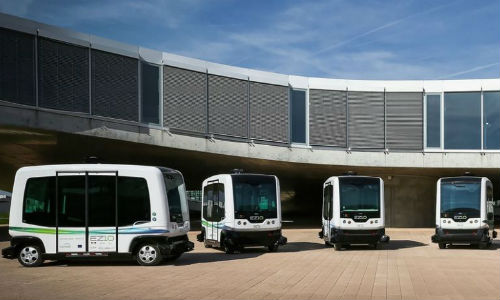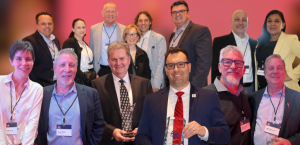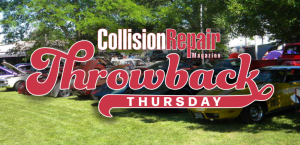By Jeff Sanford
Toronto, Ontario — May 7, 2017 — In this week’s Autonomous Report we look into statements that Tesla will open corporate bodyshops, how cities might supplement existing transit with fleets of autonomous vehicles (AVs), the coming impact on urban planning and much, much more!
– Tesla is probably most well-known to the public for its Autopilot feature, especially after a couple of high-profile failures. The company has recently said in an update to shareholders that it plans to open company-owned bodyshops, as well as expanding its network of third-party collision repair facilities:
“To significantly improve the customer experience with out-of-warranty body repairs, we intend to open the first Tesla-owned body repair shops later this year and expand the existing network of third-party Tesla certified bodyshops.”
Collision Repair magazine has asked Tesla to comment on whether any of the new centres, corporate or otherwise, would be in Canada. Inquiries had not been returned at time of publication.
– A recent blog post by Victor Cassone on The Inland Review discusses the coming tug-of-war and re-balancing of powers between the private and pubic sectors that the appearance of AVs will initiate. A central question that will eventually need to be answered: what autonomous services will be provided to the public?
“All current indications point to autonomous vehicles remaining controlled by the private industry. However, it’s easy to see where there might be conflicts in the future … If only a subset of people can afford using autonomous vehicles and these people are at an advantage because they have access to this transportation then it’s reasonable to assume a city will invest in opening up access to the people who can’t afford it,” writes Cassone. “The fleets would have a similar philosophy of city buses. The city would eat most of the operation costs but still require some sort of payment for usage. This would help bring down the cost and eliminate some of the barriers of access.”
– The recent Toronto conference on AVs organized by the Canadian Conference Board included a panel discussion on some of the urban issues. Taking part in the discussion were managers from various transportation organizations. Lisa Salsberg, Director Regional Planning, Metrolinx, was one of the panelists. Mextrolinx is a provincial organization working to knit together the various public transportation networks around the Greater Toronto Area. Could AVs render some of these projects obsolete?
Salsberg was eminently diplomatic and told the audience that the organization is asking these questions. “If we’re going to look out 25 years we can’t overlook the impact of new technologies in terms of decision about trips. The problem in our planning work is that we’re trying to understand what’s going on around us and in the world. We’ve developed a forum for that discussion to happen. We’ve done some work to underhand the attitude from different parts of the population,” said Salsberg. “Recognize the future could go this way, or that way. We don’t want to put a piece of infrastructure in the ground that doesn’t get used … We’re actually looking at how we can embed these discussions in our capital planning as a way of understanding how these technologies will influence our future. We’re building very significant rapid transit across the region. How do we think about stations and station access in terms of how we should be thinking about how people interact with transit systems? Things like AV buses to serve subway stations … these are the things we can consider. We’re thinking about things like re-adapting parking … so maybe in 15 years, when we don’t need as much parking, we can adapt those spaces … We’ve heard the need to be flexible. Understand the technology you’re regulating, regulate in a way that doesn’t hinder development.”
Also on the panel was Jamie Austin, Director of Transportation Policy at the Ministry of Transportation (Ontario). Austin said the province has no final policy on AVs, but was sure to point out that Ontario was the first jurisdiction in Canada to allow for their testing.
“That will allow us to assess the technology. We have four companies registered with the program,” said Austin. “It’s not going to be enough to be reactive … we have to think about the way we want our communities to be developed.”
Anyone interested in urban planning has to be fascinated by a potential once-in-history upgrading of the local infrastructure to utilized digital components. Vehicle to infrastructure communications will allow amazing new ways of design cities. LiDAR equipped vehicles that can generate a picture of events occurring around the car will create an amazing new level of safety and reliability. That this is an exciting time was the message form the keynote speaker, Transportation Minister Marc Garneau.
Garneau has served in the navy, headed the space agency and is well-known as the first Canadian astronaut to fly in space. Now an MP and Minister of Transportation he is also house leader. According to Garneau, the federal government is taking a leadership role in thee technologies. He noted that his recent plan, Transportation 2030, envisions a green, integrated transportation system that supports “economic growth as well as the well-being of Canada’s middle class. Unveiled last fall, we’re now putting it into place.” The plan will see eleven billion dollars flow toward infrastructure. The money will be allocated through a new Canada Infrastructure Bank. “The current CEO of the organization has just been chosen,” said Garneau.
The new chief is the departing head of Metrolinx, as it happens. Also in the mix is $2. 6 billion to create an innovation fund, technology demonstration program and an automotive innovation fund. Some of that money will eventually find its way to the AV sector, which promises to find support as the safety improvements drive adoption of the technology.
“The transportation sector is rich with examples of the new and emerging technologies. There are tremendous advances occurring in automation right now. There is a convergence of cars with high tech. Already many cars feature a fair amount of automation, including automatic breaking and lane change assist. These technologies are helping drivers avoid collisions or reducing the severity of accidents,” said Garneau.
Variable speed limits and vehicle platooning will, “help us to use roads more efficiently and help us get to where we’re going faster and use fuel more efficiently,” said Garneau. This past fall he participated in a truck platooning demonstration that Transport Canada is testing in Quebec. “I was in the middle truck. It was exhilarating. Fascinating. Cooperative platooning allows trucks to safely travel at high speeds at close quarters … special radios and sensors coordinate any change in speed and that is communicated to the other vehicles with almost instant effect,” says Garneau. “It seems possible there could be 14 percent in savings on fuel to the platoon. This is significant. It’s clear the future includes smart cars in smart cities. These technologies are at the heart of our innovation agenda. Emissions from car and trucks the high source of emissions in the economy. This will help us achieve reduction goals.”
Garneau said it is hard to pinpoint a timeline for adoption, but he does think AVs are the next big thing.
“Some say that full automation is more than a decade away, both in terms of safety and reliability. Other say this is just around corner … Level Five automation will take some time. Many challenges still need to be resolved [at that level]. And we’ll have to carefully manage the transition from non-automated through a time when both are on the roads. But AVs do seem poised to be the next disruptive tech.”
According to Garneau, Transport Canada is looking at hardware reliability and driver acceptance, and he noted there are big challenges yet and hurdles to overcome. “Driving is a complex task … and these vehicles must be operable in all weather conditions … The safety record will have to be consistent across the North American continent before we allow this,” said Garneau. Even so the sector is evolving. “We’re already working with the US so that AVs can work on both sides of the border … Clearly, the transportation sector is at a turning point. Innovation in transportation has always been crucial to our development as a country. AV tech has immense potential. And it will have a great impact on our country. I think a fascinating future awaits us.”





































